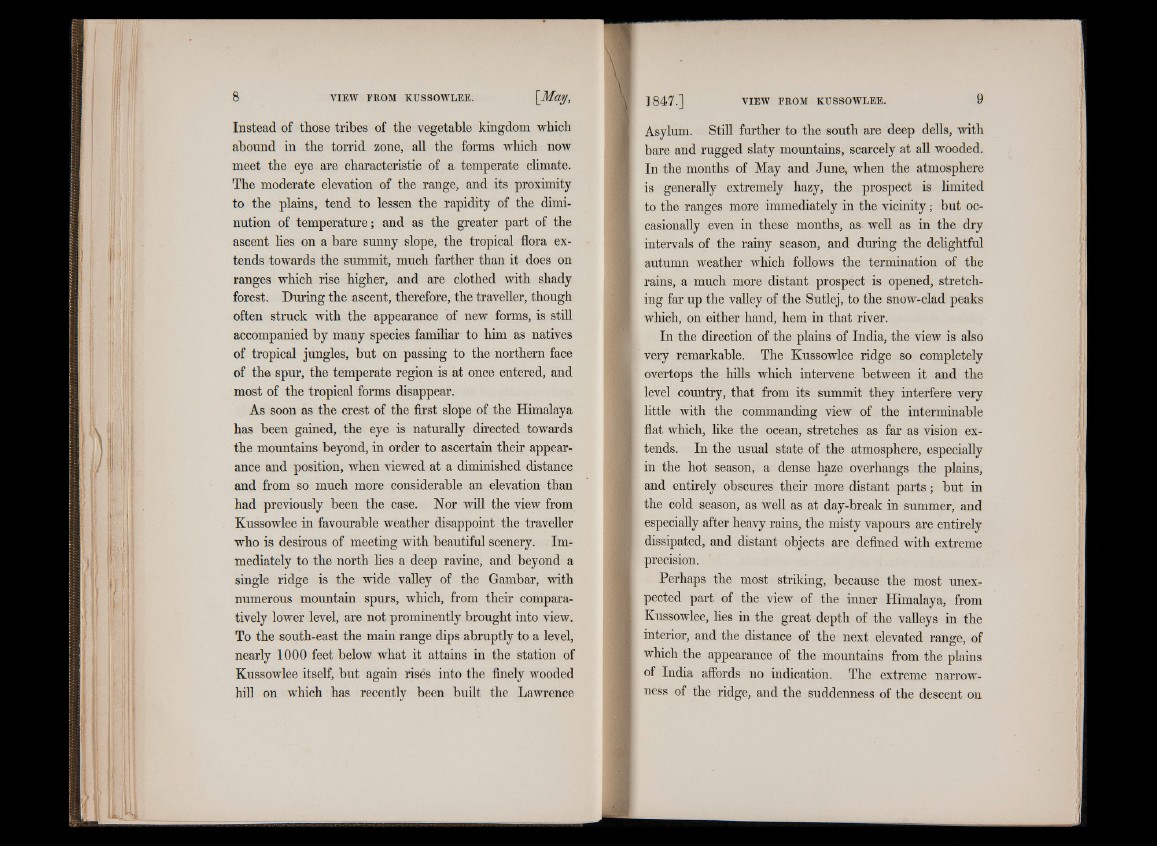
Instead of those tribes of the vegetable kingdom which
abound in the torrid zone, all the forms which now
meet the eye are characteristic of a temperate climate.
The moderate elevation of the range, and its proximity
to the plains, tend to lessen the rapidity of the diminution
of temperature; and as the greater part of the
ascent lies on a bare sunny slope, the tropical flora extends
towards the summit, much farther than it does on
ranges which rise higher, and are clothed with shady
forest. During the ascent, therefore, the traveller, though
often struck with the appearance of new forms, is still
accompanied by many species familiar to him as natives
of tropical jungles, but on passing to the northern face
of the spur, the temperate region is at once entered, and
most of the tropical forms disappear.
As soon as the crest of the first slope of the Himalaya
has been gained, the eye is naturally directed towards
the mountains beyond, in order to ascertain their appearance
and position, when viewed at a diminished distance
and from so much more considerable an elevation than
had previously been the case. Nor will the view from
Kussowlee in favourable weather disappoint the traveller
who is desirous of meeting with beautiful scenery. Immediately
to the north lies a deep ravine, and beyond a
single ridge is the wide valley of the Gambar, with
numerous mountain spurs, which, from their comparatively
lower level, are not prominently brought into view.
To the south-east the main range dips abruptly to a level,
nearly 1000 feet below what it attains in the station of
Kussowlee itself, but again rises into the finely wooded
hill on which has recently been built the Lawrence
Asylum. Still further to the south are deep dells, with
bare and rugged slaty mountains, scarcely at all wooded.
In the months of May and June, when the atmosphere
is generally extremely hazy, the prospect is limited
to the ranges more immediately in the vicinity; but occasionally
even in these months, as well as in the dry
intervals of the rainy season, and during the delightful
autumn weather which follows the termination of the
rains, a much more distant prospect is opened, stretching
far up the valley of the Sutlej, to the snow-clad peaks
which, on either hand, hem in that river.
In the direction of the plains of India, the view is also
very remarkable. The Kussowlee ridge so completely
overtops the hills which intervene between it and the
level country, that from its summit they interfere very
little with the commanding view of the interminable
flat which, like the ocean, stretches as far as vision extends.
In the usual state of the atmosphere, especially
in the hot season, a dense haze overhangs the plains,
and entirely obscures their more distant parts; but in
the cold season, as well as at day-break in summer, and
especially after heavy rains, the misty vapours are entirely
dissipated, and distant objects are defined "with extreme
precision.
Perhaps the most striking, because the most unexpected
part of the view of the inner Himalaya, from
Kussowlee, lies in the great depth of the valleys in the
interior, and the distance of the next elevated range, of
which the appearance of the mountains from the plains
of India affords no indication. The extreme narrowness
of the ridge, and the suddenness of the descent on